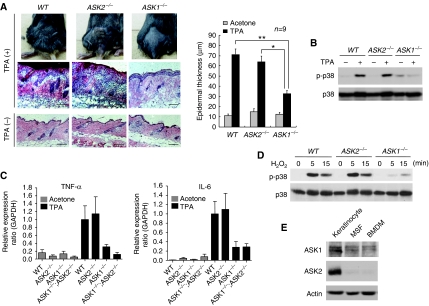Figure 7.
ASK1-dependent inflammatory response is required for tumour promotion. (A) TPA-induced inflammatory response is reduced in ASK1−/− mice. The dorsal skin of WT, ASK2−/− and ASK1−/− mice was treated twice with acetone (TPA (−)) or TPA (10 μg each) with 24 h interval. Mice were killed 48 h after the latter treatment, and skin sections were processed for hematoxylin-eosin staining. Images are representatives of nine mice for each genotype. Scale bar=100 μm. Macroscopic observations of the dorsal skin of TPA-treated mice are also shown (left top panels). Quantification of epidermal thickness of these mice is shown in a graph on the right. Values are the mean±s.e.m. (n=9). *P<0.05, **P<0.01, compared with TPA-treated WT mice. (B) TPA-induced activation of p38 is attenuated in ASK1−/− skin. Acetone and 10 μg TPA were independently applied to separate areas of the dorsal skin of the same mouse. Mice were killed at 24 h after treatment, and each treated region of skin was excised and lysed and then subjected to immunoblotting. (C) Induction of TNF-α and IL-6 is attenuated in TPA-treated skin of ASK1−/− and ASK1−/−;ASK2−/− mice. The dorsal skin of WT, ASK2−/−, ASK1−/− and ASK1−/−;ASK2−/− mice was treated with acetone or 10 μg TPA. Mice were killed 24 h after the treatment, and RNA was extracted from the treated skin. mRNA expression of TNF-α and IL-6 was quantified using real-time RT–PCR. Data are mean±s.e.m. (n=4 for TPA-treated mice and n=3 for acetone-treated mice). (D) H2O2-induced activation of p38 is reduced in bone marrow-derived macrophages (BMDMs) from ASK1−/− mice, but not from ASK2−/− mice. WT, ASK2−/− and ASK1−/− BMDM were treated with 0.3 mM H2O2 for the indicated periods. Cell lysates were subjected to immunoblotting. (E) Comparison of ASK1 and ASK2 protein expression among primary cultured mouse cells. Cell lysates from primary keratinocytes, mouse skin fibroblasts (MSF) and BMDM were subjected to immunoblotting.

